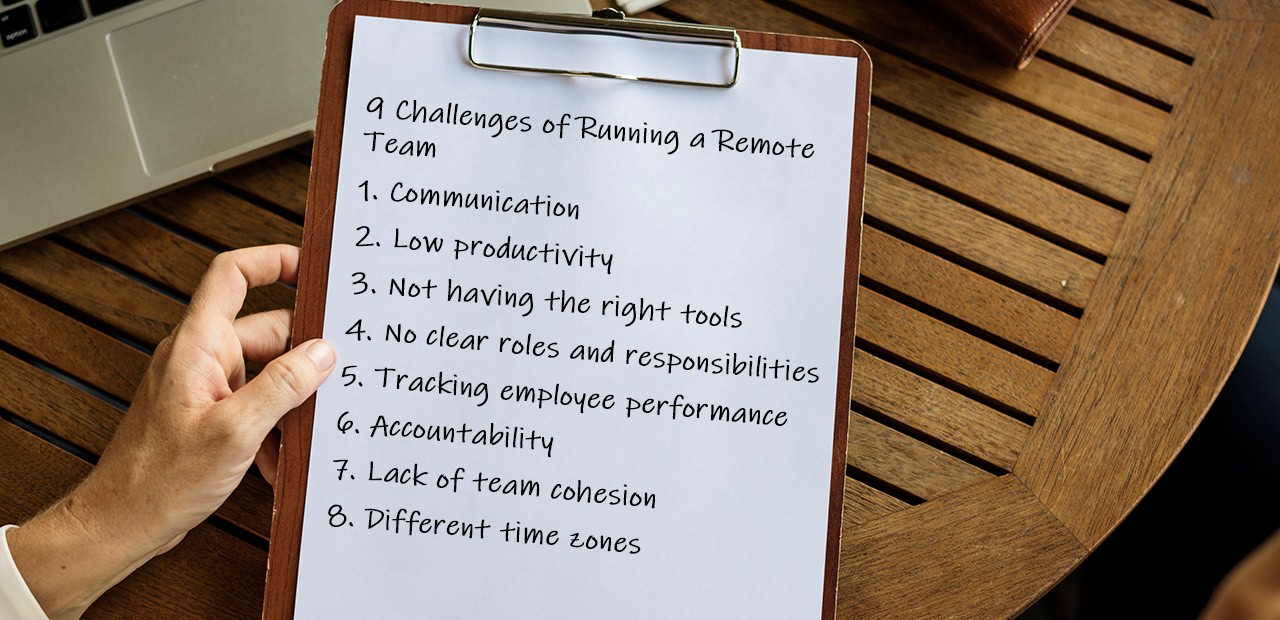11+ Valuable Strategies and Best Practices for Remote Teams Management

Because remote teams don’t have the same face-to-face interaction that traditional office teams enjoy, remote teams management can be tricky. If you’re running a remote team, it’s important to have policies in place for managing your workers effectively. And with the right tools, you can create an environment where remote employees feel connected and productive.
Curious about how you can improve your remote teams management skills? Read on for our best tips on managing a distributed workforce and how you can best support subordinates working remotely.

What is a Remote Team?
Unlike co-located or onsite teams, a remote team has members working from different locations, sometimes from all over the world. This type of team structure is becoming more and more popular as organizations increasingly embrace the benefits of hiring talent from anywhere in the world.
There are many advantages to working with remote teams. First, you have access to a much wider pool of talent. You’re no longer limited to hiring people who live near your office or who are willing to relocate. This means you can find the absolute best person for each role, regardless of location.
Second, remote teams tend to be more productive and motivated than traditional teams. Studies have shown that employees who work remotely are more engaged with their work and take less time off than on-site workers.
Finally, remote teams can save your organization a lot of money. You don’t have to provide office space or pay for employee benefits like health insurance and retirement plans. And since employees working remotely are usually more productive, you’re getting more bang for your buck.
Of course, some challenges come with managing remote teams.

Challenges of Running a Remote Team
The biggest challenge of running a remote team is communication. It can be difficult to keep everyone on the same page when you’re not all in the same place. You have to be intentional about creating opportunities for remote employees to connect with each other and with you.
Another challenge is managing remote employees’ work-life balance. It can be hard to know if someone is working too much or not enough when you can’t see them in person. And since remote employees are usually responsible for their own schedule, it’s easy for work to bleed into their personal life.
Finally, remote teams can be more susceptible to security risks. Since remote employees often work from unsecured locations, they can be more vulnerable to hacking and cyberattacks.
Common remote teams management issues include:
-
Communication
One of the biggest challenges of running a remote team is communication. It can be difficult to keep everyone on the same page when you can’t have regular face-to-face meetings. You also need to be careful about time zone differences and ensure everyone has the same access to information.
-
Low productivity
Another challenge of working remotely is productivity. It can be hard to stay on task when you’re not in an office environment. And without the ability to pop into someone’s office for a quick question or have team meetings, it can take longer to get things done.
-
Not having the right tools
Another common challenge when managing remote teams is not having the right tools. It can be difficult to keep track of projects and stay connected with team members without the right tools. This can include everything from project management software to video conferencing tools.
-
No clear roles and responsibilities
Another issue that can arise is not having clear roles and responsibilities for team members. This can lead to confusion about who should do what, ultimately slowing down productivity.
-
Tracking employee performance
When it comes to performance, remote team members can be harder to keep track of. This is because you’re not able to see them working on a daily basis. As a result, it can be more difficult to identify issues and provide feedback.
-
Accountability
Accountability can be a challenge when managing remote teams. This is because it’s harder to hold team members accountable for their work when you’re not in the same physical space.
-
Lack of team cohesion
Remote teams can sometimes lack the cohesion that traditional office teams have. This can make it difficult to build relationships and trust among team members.
-
Different time zones
Another challenge that remote teams face is different time zones. This can make it hard to schedule team meetings and calls and can lead to miscommunication.
-
Social isolation
Remote employees can sometimes feel isolated from their team members. This can lead to feelings of loneliness and make staying motivated difficult.
Now that we’ve discussed some of the challenges of remote teams management, let’s take a look at some strategies for overcoming them.

Valuable Strategies to Help SMBs and Managers with Remote Employees
1. Create clear roles and responsibilities
One of the best ways to manage a remote team is to create clear roles and responsibilities for each team member. This will help everyone know what their job is and what they should be working on.
2. Use a project management software
Another essential step when managing a remote team is orienting everyone on using project management software. Apps like Asana and Trello will help you keep track of projects and team members. This will help you stay organized and on top of things.
3. Set up regular check-ins
Schedule weekly syncs, huddles, or status updates with team members. This can be done through video conferencing or audio calls. Checking in regularly will help you stay connected and aligned with team members.
4. Use a time tracking software
For a better view of how much time each team member is spending on tasks, use time tracking apps like Hubstaff, Toggl, or Screenmeter (or work with virtual staffing agencies like 20four7VA, which has a FREE time tracking app). This tool can help you identify areas where productivity is low. It will also help you enforce improvements for better time management.
5. Set up a remote work policy
If you’re managing remote employees, you need to have remote work guidelines in place. A company- or team-wide remote work policy helps create a remote working environment that allows the entire team to thrive. It includes things like working hours, communication expectations, team access to work-related tools, and more.
6. Encourage transparency and communication
Another important strategy is to encourage transparency and communication among team members. This means creating an environment where everyone feels comfortable asking questions and sharing ideas. A chat room or video conferencing software for virtual meetings or video chats can be helpful for this.
7. Be organized and prepared
One of the best things you can do as a remote team manager is to be organized and prepared. This means having all of your ducks in a row before meetings and being available to answer any questions team members may have.
8. Collaborate and build relationships
Finally, collaboration is important in managing remote employees and building relationships with the people you work with. This can be done through regular check-ins and communication. By building relationships, you’ll create a more cohesive team that trusts and respects one another.

Helpful Best Practices for Managing Remote Teams
Technology has empowered us in many ways, especially in achieving our professional goals. Through various apps and software, you can launch your own business and manage day-to-day operations with ease. You can even have your own staff through virtual assistant companies.
Remote staffing has many advantages, one of which is the savings you can get from doing away with a physical office. Everything happens online—communication, task management, project tracking, payroll, etc.
However, while managing a remote office assistant can be easy, supervising a team of remote workers poses more challenges.Here are a few tips for managing a remote team.
-
Enforce a streamlined process
Having a process is crucial in accomplishing projects on time, so you need to create a workflow that will enable your team to carry out tasks efficiently. Nevertheless, each person may have their own processes, which isn’t bad as long as they don’t get in the way of how the other team members are working. In such a case, you and your team should discuss your remote working processes as a team and as individuals with different skills.
-
Utilize the right tools
The right tools will help you organize your team and keep workers up to date. Some essential tools for remote teams management are email, project management software, instant messaging, file sharing, screen sharing, and others that may be specific to your industry.
-
Regularly communicate with your remote team
Communication is key in any organization, so it’s important to ask your team from time to time how they’re doing. You can use a communication tool like Skype for meetings or video calls or instant messaging apps like Slack if you need a quick way to reach your virtual staff.
-
Ensure that your goals are aligned with your team’s
It’s not enough to explain what has to be done. You should also set clear goals and objectives for your employees. Make sure they understand why something needs to be done; this will enable them to assist you in the most effective way possible. This allows them to be more proactive as well. They will have a greater sense of judgment when it comes to decision-making.
-
Trust your team
If you can trust everyone on your team, you will have good working relationships with them. It will show in the overall dynamics of the team, and when this is the case, members can work more efficiently, and everyone can produce a desirable output.
The recruitment process for remote workers is tricky, so you should be certain that you can trust the person you’re hiring before the onboarding process. Don’t hire someone you have doubts about (even small ones); it will only prove counterproductive and stressful.

Remote Teams Management Tips for Managers
If you manage remote teams or are thinking about it, here are some tips to help you succeed:
1. Understand the preferences of your remote team members
Your remote workers are likely to have different opinions about working remotely. Some would prefer to stick to a strict 9–5 schedule, while others might be more comfortable with flexible hours. It’s important to understand the preferences of each member of your remote workers to manage remote teams effectively.
2. Set clear expectations
When working with a remote team, setting expectations early and clearly from the outset is important. Let your team know what you expect from them regarding work hours, deadlines, and communication regardless of time zones or cultural differences. This will help everyone stay on track and avoid any misunderstandings.
3. Develop a system for tracking progress
It can be difficult to keep track of everyone’s progress when you’re in a remote environment. This is why developing a system for tracking progress and holding team members accountable is important. There are several remote teams management tools that can help with this, such as Asana or Trello.
4. Overcommunicate
When managing remote teams, it’s important to overcommunicate. This means sending more updates and checking in more often than you might if everyone was in the same office. This will help ensure everyone is on the same page and avoid miscommunications.
5. Be flexible
While setting ground rules and clear expectations is important, you must also be flexible when working with a remote team. There will inevitably be times when someone needs to take a sick day or take care of a personal matter. When this happens, it’s important to be understanding and accommodating.

Bonus: How to Identify and Deal with Remote Work Burnout
Burnout is a very real problem for many people who work remotely. Answer: Symptoms of work burnout can include the following:
- Feeling overwhelmed or underutilized at work
- Lack of interest in work or feeling apathetic toward your job
- Trouble concentrating or focusing on tasks
- Feeling tense or stressed out often, especially during the workweek
- Fatigue, low energy, and/or insomnia during the weekdays
- Difficulty managing emotions, such as feeling irritable, angry, or impatient more often than usual
- A decrease in productivity or motivation to do your best work
- Neglected social life and activities due to excessive workloads and stressors related to work demands
- Feeling cynical or negative about your job or company
If you’re experiencing any of these symptoms, it’s important to take a step back and assess your work-life balance. Are you working too much? Do you need more time for yourself? Are there any changes you can make to your work schedule or environment to improve your situation?

Here are a few things that can help prevent burnout:
-
Take a break
Sometimes, the best way to deal with burnout is to take some time away from work altogether. This can be a mental break, where you unplug from all devices and relax, or a physical break, where you get up and move around for a bit.
-
Rethink your routine
Are there any changes you can make to your routine that might help alleviate some of the stress? Maybe you need to wake up a bit earlier to get a head start on the day, or maybe you need to take more breaks throughout the day.
-
Set boundaries
One of the best ways to avoid burnout is to set boundaries between work and life. This means setting clear limits on when you will and will not work. It also means learning to say no to additional work commitments when you’re already feeling overwhelmed.
-
Talk to loved ones and friends
When you’re feeling burned out, it’s important to talk to someone about it. This can be a friend, family member, therapist, or anyone else who will understand and provide support.
-
Delegate tasks
If you’re overwhelmed by your workload, delegate some tasks to someone else. This will help lighten your load and give you time to focus on other things.
-
Stay organized
One of the best ways to avoid burnout is to stay organized. This means having a clear plan for your day and week and knowing what tasks need to be done and when.
-
Eat healthy foods and stay hydrated
Eating healthy foods and staying hydrated can help improve your energy levels and mood.
-
Get enough sleep
Getting enough sleep is crucial for preventing burnout. Aim for at least eight hours of sleep each night.
-
Ask for help
Talk to your boss or a trusted co-worker if you feel overwhelmed by your workload. They may be able to help you delegate tasks or adjust your schedule.
If you’re struggling to manage remote work burnout on your own, it’s also important to seek help from a mental health professional. They can provide additional resources and support to help you cope with stress and improve your work-life balance.
Key takeaways
So, what have we learned about leading and managing your team remotely? First and foremost, it’s important to be aware of the challenges of this type of working arrangement. However, with careful planning and helpful strategies, SMBs and managers can successfully manage a remote workforce. Have you had any experience managing teams in a remote setting? What tips for remote teams management would you add to this list? Let us know in the comments below!










